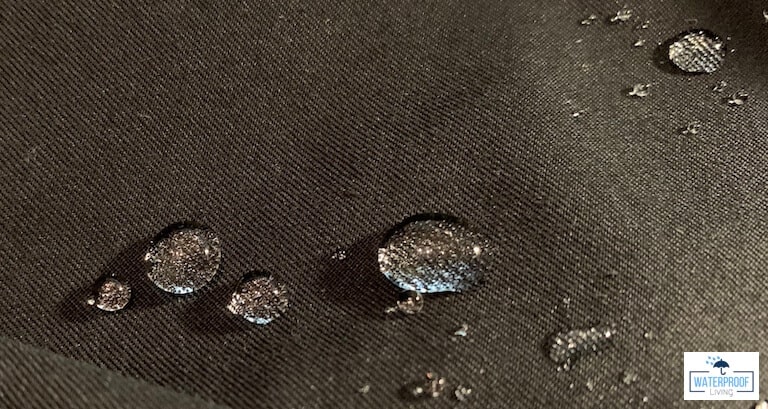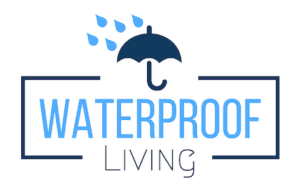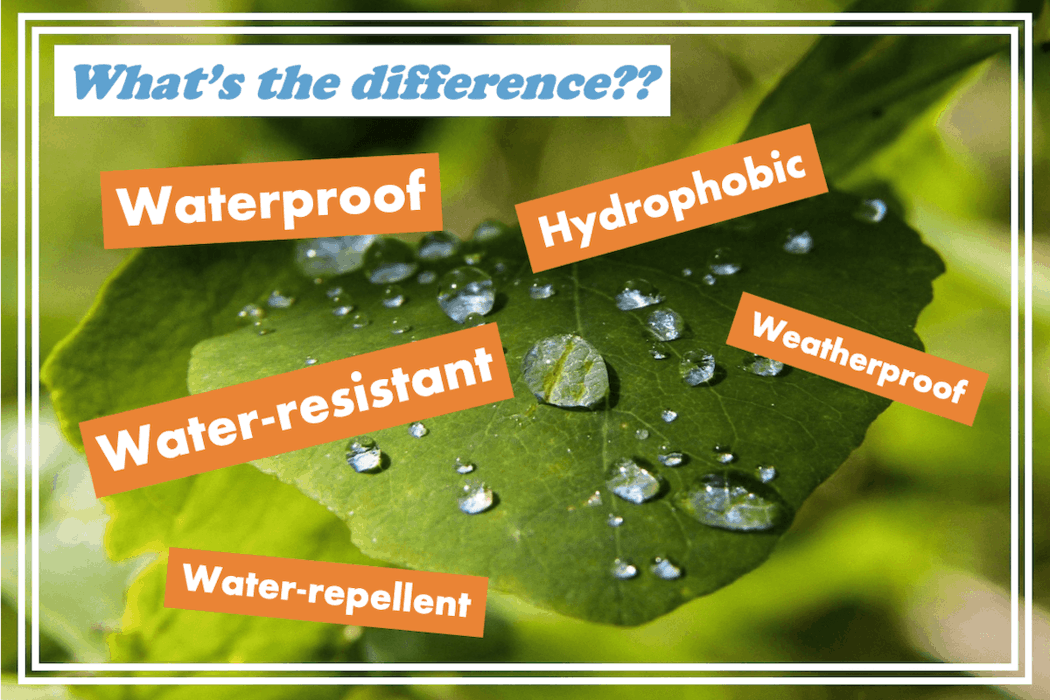Many industries, such as the clothing-, construction- and electronic device industry use these five terms (and variants such as splash-proof and damp-proof). However, what does it mean when something is said to be waterproof, hydrophobic, water-resistant, water-repellent, or weatherproof? Are they synonyms?
In short, most industries use the term waterproof, and it means “impervious to water and unaffected by water.” The science branches use hydrophobic most often. However, unlike waterproof, hydrophobic is rarely used to intend “unaffected by water” but more “impervious to water.” In contrast to waterproof, where something is proclaimed to be 100% impervious to water, water-resistant products/materials may be impervious to water to some degree but not entirely. Water-repellant closely relates to water-resistant and hydrophobic. Lastly, weatherproof is “able to withstand exposure to weather without damage or loss of function.”
In this article, we’ll discuss their definitions and how they differ from each other.
Waterproof
Popular dictionaries such as the Oxford English Dictionary and Merriam-Webster give the definition: “impervious to water.” (source1, source2) Impervious had two meanings. The first is “not letting something enter or pass through.” The second is “not bothered or affected by something.” (source) As you may have guessed, in this case, that “something” is water.
The first definition of impervious has a similar meaning to proof. Proof means “able to resist or repel.” (source) However, “able to resist” would suggest that waterproof and water-resistant would say the same thing. Not exactly. I will explain the difference between the two later on.
The second definition of impervious means that something may get damaged or not stay in the same state after it has been in contact with water.
However, be careful when you hear companies use the term waterproof because it’s tough to achieve. They most likely mean water-resistant (read why in paragraph water-resistant).
Apart from these two definitions, you can use the term waterproof as a figure of speech, such as a plan can be waterproof. The plan will most likely succeed.
Waterproofing is the process of making something waterproof and is “used in reference to building structures (such as basements, decks, or wet areas), watercraft, canvas, clothing (raincoats or waders), electronic devices and paper packaging (such as cartons for liquids).” (source)
According to google trends, the term waterproof is by far most widely used compared to the other terms. (source)
Hydrophobic
The term hydrophobic is the most scientific compared to the other terms. According to Biologydictionary, hydrophobic means “the fear of water.” (source) People rarely use this term when they mean “not affected by water.” They usually want to say something along the lines of “not letting water pass through.”
Biologydictionary says, “hydrophobic molecules and surfaces repel water. Hydrophobic liquids, such as oil, will separate from water. Hydrophobic molecules are usually nonpolar, meaning the atoms that make the molecule do not produce a static electric field.” (source)
If a surface is hydrophobic, it can make water do incredible things. See the video below!
A study related to hydrophobicity that blew me away had to do with Morpho butterflies. These butterflies have wings like no other butterfly. They have what’s called superhydrophobic wings. They can fly through rain because the drops will skid right off! Things that are superhydrophobic, or even ultra-hydrophobic, have a little “more fear of water” of water than only hydrophobic. That has to do with how the surface is structured.

The surface redistributes the liquid mass so that it no longer spreads and retracts symmetrically. “Theory and experiments confirm that this strategy shortens the contact time between a bouncing drop and a surface beyond what was thought possible.” (source)
Water-resistant
The Oxford English Dictionary gives the following definition for water-resistant: “able to resist the penetration of water to some degree but not entirely.” (source) In contrast to waterproof, where something is proclaimed to be 100% impervious to water, water-resistant products or materials may be impervious to water to a certain level.
The term water-resistant gets used often in standards and ratings in many industries. Two industry examples are in the electronic devices- and watch production.
Electronic devices (mobile phones) – Do you wonder how water-resistant your electronic device is, such as your mobile phone? Check the IP Code. IP codes (Ingress Protection ratings) are defined in international standard EN 60529 (British BS EN 60529:1992, European IEC 60529). These codes are used “to define levels of sealing effectiveness of enclosures against intrusion from foreign matter (tools, dirt, etc.) and moisture.” (source) The code starts with IP, usually followed by two digits. The first digit indicates solids protection. The second digit indicates liquid protection. The levels for liquid protection go from “not protected” to “immersion beyond 1 meter”.
I found the level of water-resistance for my iPhone on the Apple website under Technical Specifications. My iPhone has IP code IP68, which means it is protected from immersion in water with a depth of more than 1 meter. Apple must specify the exact depth to be allowed to give this standard. They mention it to be 2 meters.
Watches – It is complicated to produce waterproof watches because taking a watch diving means it has to cope with pressure. The International Organization for Standardization (ISO), an independent, non-governmental international organization, issued the Water-Resistant mark. Popular standards are ISO 2281 and ISO 6425. ISO 2281 is “designed for watches intended for ordinary daily use and are resistant to water during exercises such as swimming for a short period.” (source)
However, these numbers don’t tell you what you should or shouldn’t do with your watch. Read about the water-resistance of your watch in the watch resistance guide by JS Watch co. They explain very clearly the extent to which your watch is water-resistant. I was surprised to see that I shouldn’t take my watch swimming when I thought it was okay!
Water-repellent
Merriam-Webster gives the following definition for water-repellent: “treated with a finish that is resistant but not impervious to penetration by water.” (source) This definition would closely relate water-repellent to water-resistant and hydrophobic.
Similar to hydrophobic, people rarely use the term when they mean “not affected by water.” They usually say something along the lines of “not letting water pass through.” However, it is not a term often used in science.
Weatherproof
As mentioned under the heading waterproof, proof means “able to resist or repel.” (4) As you may have guessed, the term weatherproof doesn’t only restrict a product or material to be impervious to water but also wind, for example. According to Merriam-Webster, it is “able to withstand exposure to weather without damage or loss of function.” (source)
Closing remarks
In this article, we covered the definitions of waterproof, hydrophobic, water-resistant, water-repellent, or weatherproof. These terms have very similar meanings, and many industries use them. However, they can sometimes be used in the same situation and sometimes not.
Key points:
- Waterproof means “impervious to water and unaffected by water.”
- Hydrophobic is rarely used to mean “unaffected by water” but more “impervious to water.”
- In contrast to waterproof, where something is proclaimed to be 100% impervious to water, water-resistant products or materials may be impervious to water to some degree but not entirely.
- Water-repellant closely relates to water-resistant and hydrophobic.
- Weatherproof is “able to withstand exposure to weather without damage or loss of function.”
- The term waterproof is by far most widely used compared to the other terms. Be careful when someone uses it; they may mean water-resistant.
References
- Hydrophobic – biologydictionary.net
- Impervious – merriam-webster.com
- IP Code – wikipedia.org
- Proof – merriam-webster.com
- Reducing the contact time of a bouncing drop – nature.com
- Waterproofing – wikipedia.com
- Waterproof – oxforddictionaries.com
- Waterproof – merriam-webster.com
- Waterproof, hydrophobic, water-resistant, water-repellant, weatherproof – trends.google.com
- Water-repellent – merriam-webster.com
- Water-resistant – oxforddictionaries.com
- Water resistant mark – wikipedia.org
- Weatherproof – merriam-webster.com

